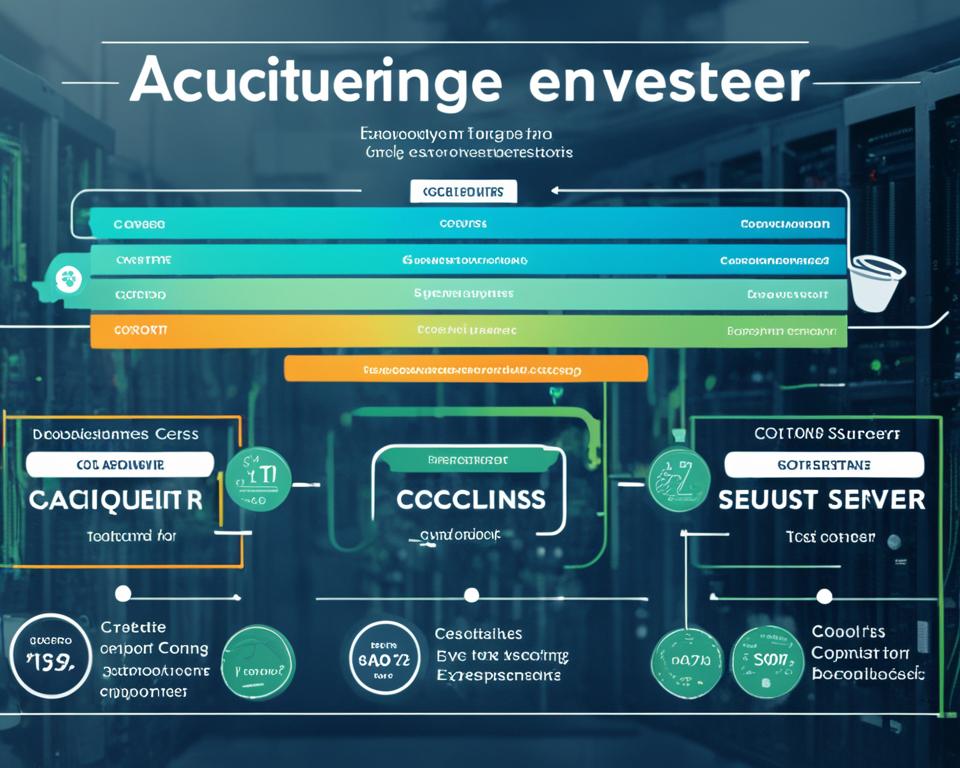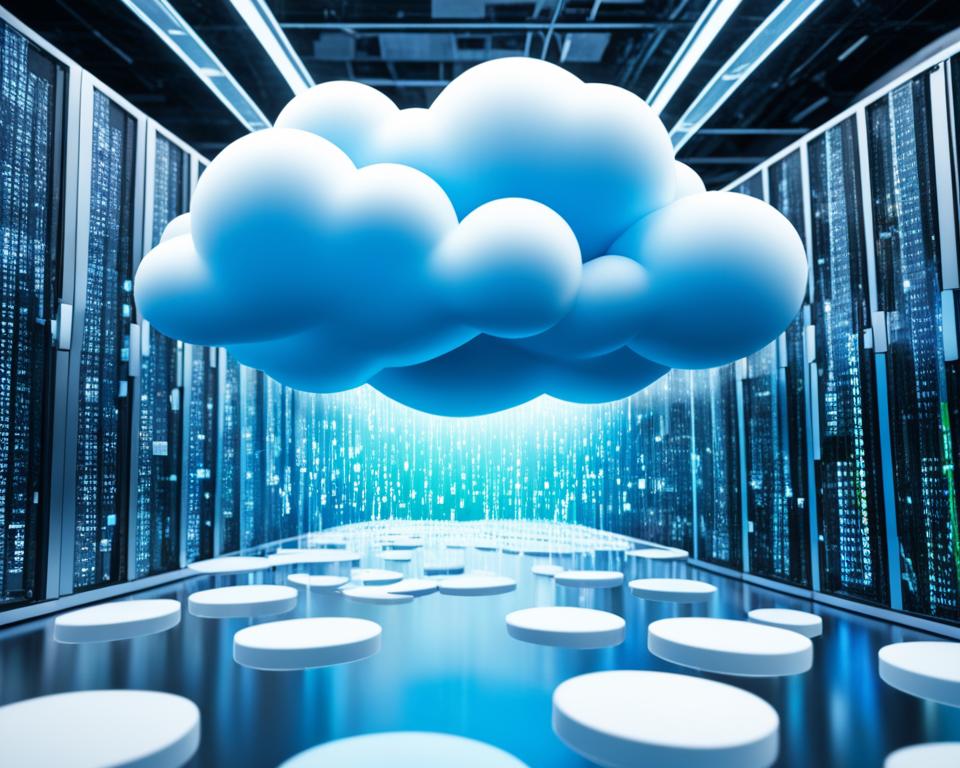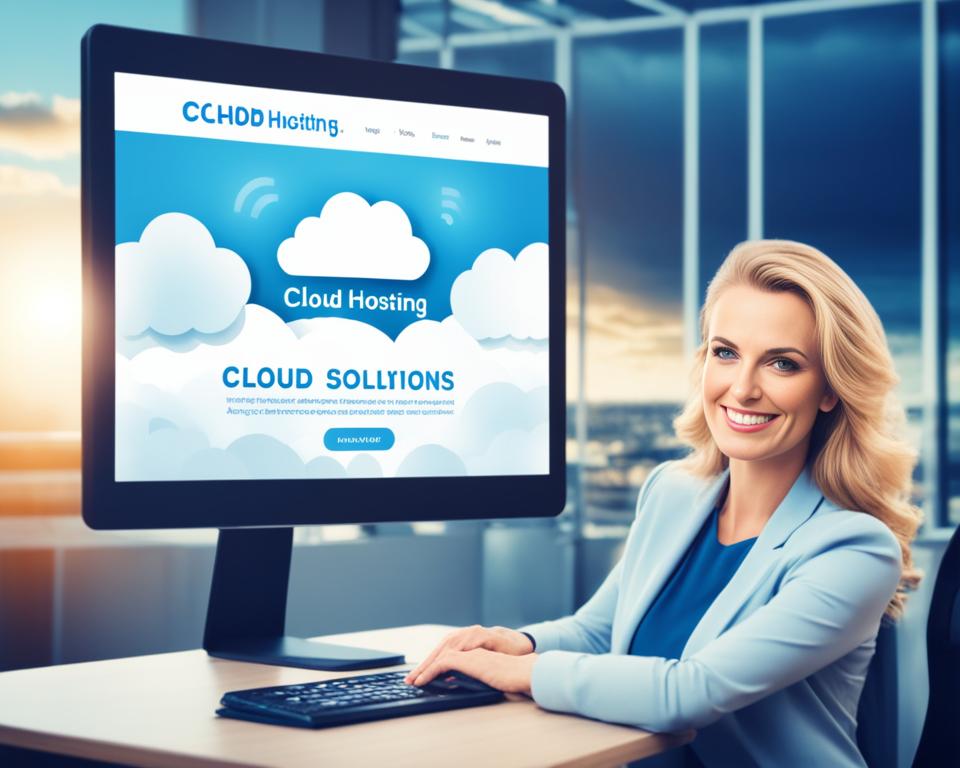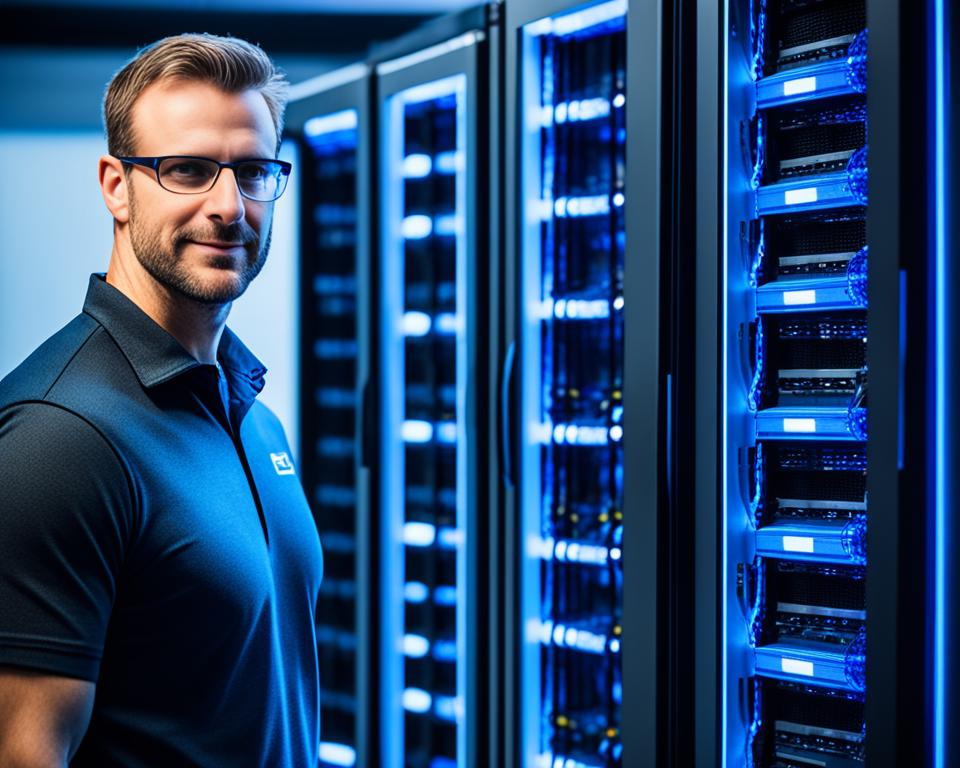The global server market revenue has surpassed $91 billion, highlighting the increasing importance of servers in businesses. Understanding the various costs associated with servers is crucial for making an informed decision. This comprehensive guide will explore key considerations and factors that influence server pricing, including hardware costs, software costs, setup costs, maintenance costs, energy costs, connectivity costs, security costs, redundancy and backup costs, and depreciation costs.
When considering a dedicated server for your business, it’s important to have a clear understanding of the pricing involved. Dedicated servers offer the advantage of providing exclusive resources and enhanced performance, but they also come with specific costs that need to be considered. By breaking down these costs, you can make a more informed decision and find the best value for your investment.
Key Takeaways:
- The cost of a dedicated server includes various factors such as hardware, software, setup, maintenance, energy, connectivity, security, redundancy, and backup.
- Hardware costs vary based on the components and specifications you choose, and more advanced hardware will generally come at a higher price.
- Software costs include the operating system, licenses, and additional applications, and ongoing maintenance and updates should also be considered.
- Setup costs encompass the installation, configuration, and deployment processes of the server, which are crucial for a reliable infrastructure.
- Maintenance costs include regular updates, repairs, and general preservation techniques to ensure optimal performance and longevity.
Understanding Server Costs: A Breakdown
To understand how much a dedicated server costs, it’s important to break down the different expenses involved. This includes hardware costs, software costs, setup costs, maintenance costs, energy costs, connectivity costs, security costs, redundancy and backup costs, and depreciation costs. Each of these factors contributes to the overall pricing of a server and should be considered when budgeting for a dedicated server.
Factors Affecting Server Pricing
- Hardware Costs: The cost of server components, such as networking equipment, memory, storage, and processors, can vary based on performance, quality, and scalability.
- Software Costs: This includes operating system licenses, software licenses, and additional applications and tools.
- Setup Costs: Expenses related to the installation, configuration, and deployment processes of a server, including physical installation and software setup.
- Maintenance Costs: Regular maintenance, updates, and repairs of hardware and software components to ensure optimal performance and longevity.
- Energy Costs: Servers consume a significant amount of energy, and factors such as cooling requirements and hardware efficiency impact energy costs.
- Connectivity Costs: The establishment and maintenance of secure and reliable internet connections, including dedicated lines and bandwidth fees.
- Security Costs: Measures to protect servers against cyber threats, including antivirus software, intrusion detection systems, and firewalls.
- Redundancy and Backup Costs: Investments in redundant network connections, backup solutions, and hardware and software components to minimize downtime and data loss.
- Depreciation Costs: The decrease in value of server components over time, which should be accounted for in the overall pricing.
By analyzing each of these factors, businesses can gain a comprehensive understanding of server pricing and make informed decisions that align with their budget and requirements.
| Factors Affecting Server Pricing | Examples |
|---|---|
| Hardware Costs | Networking equipment, memory, storage, processors |
| Software Costs | Operating system licenses, software licenses, additional applications and tools |
| Setup Costs | Physical installation, software configuration, deployment processes |
| Maintenance Costs | Regular updates, repairs, security and encryption updates |
| Energy Costs | Power consumption, cooling requirements |
| Connectivity Costs | Dedicated lines, bandwidth fees, internet connection quality |
| Security Costs | Antivirus software, intrusion detection systems, firewalls |
| Redundancy and Backup Costs | Redundant network connections, backup solutions, hardware and software components |
| Depreciation Costs | Decrease in value of server components over time |
Understanding the breakdown of server costs allows businesses to analyze pricing, compare options, and make strategic decisions when investing in a dedicated server.
Hardware Cost
In the realm of dedicated servers, hardware cost plays a significant role in determining the overall value and capabilities of the server. When investing in a dedicated server, businesses need to consider the various hardware components that contribute to the server’s performance and functionality. These components include networking equipment, memory, storage, and processors.
The cost of these server components varies based on their performance, quality, and scalability. Generally, more advanced hardware options with higher specifications tend to come with a higher price tag. This is because they offer greater processing power, faster data transfer rates, and enhanced storage capabilities.
For businesses with heavy workloads or demanding applications that require exceptional performance, investing in higher-end hardware options becomes crucial. By opting for superior hardware, businesses can ensure smoother operations, reduced response times, and improved overall productivity.
However, it is important to strike a balance between hardware capabilities and budget constraints. Small businesses or those with lower resource requirements may find cost-effective hardware options that meet their needs without breaking the bank. Keyword: affordable dedicated server cost
The Impact of Hardware Cost on Server Performance
The hardware cost directly influences the performance and capabilities of a dedicated server. By investing in high-quality, powerful hardware, businesses can expect faster data processing, superior multitasking capabilities, and enhanced storage capacity. These factors translate into improved application performance, reduced latency, and greater efficiency in handling client requests. Keyword: server hardware cost
On the other hand, opting for lower-end hardware options may result in subpar server performance, particularly when dealing with resource-intensive applications or high user traffic. Slow response times and decreased processing capabilities can negatively impact user experience and potentially lead to lost business opportunities. Therefore, it is crucial to strike a balance between cost and performance when choosing hardware for a dedicated server.
| Hardware Component | Average Cost |
|---|---|
| Networking Equipment | $500 – $2,000 |
| Memory (RAM) | $80 – $200 per GB |
| Storage | $0.10 – $0.50 per GB |
| Processors | $200 – $2,000+ |
This table provides a general range of the average cost for common hardware components found in dedicated servers. However, it’s important to note that prices can vary depending on factors such as brand, quality, specific hardware models, and market demand. Conducting thorough research and consulting with industry experts can help businesses identify the most suitable hardware options within their budgetary constraints.
Investing in high-quality hardware may incur a higher upfront cost, but the improved performance and scalability are often worth the investment in the long run.
Software Cost
The software cost is an important component of dedicated server pricing. It encompasses various elements such as the operating system, software licenses, and additional applications and tools. Different operating systems have varying licensing fees, and specific software components may require subscriptions or licenses.
When considering the software cost, it is essential to take into account regular maintenance and updates of software components. This ensures that the server remains secure, up-to-date, and optimized for performance.
“Investing in reliable and secure software is crucial for the smooth operation of a dedicated server.”
Choosing the right operating system and software applications is vital to meet specific business requirements. Some businesses may opt for open-source software to minimize software costs, while others may prefer proprietary solutions that offer additional features and support.
Operating System Cost
The operating system (OS) is a critical component of a dedicated server as it determines its functionality and compatibility with applications. Different operating systems, such as Windows, Linux, or macOS, have varying costs associated with them.
For example, Windows Server requires a licensing fee, which adds to the overall software cost. On the other hand, Linux-based operating systems, such as Ubuntu, CentOS, or Debian, are often open-source and freely available, reducing the software cost involved.
Software Licenses Cost
In addition to the operating system, specialized software licenses may be required for specific applications or tools. These licenses ensure legal compliance and access to updates and support from software vendors.
For example, database management systems like Microsoft SQL Server or Oracle Database may require separate licenses. Other software tools, such as control panel applications or development frameworks, may also have associated costs for licenses or subscriptions.
Regularly evaluating software needs and costs is vital as different applications and tools require specific licenses. By optimizing software usage and considering cost-effective alternatives, businesses can effectively manage their software costs while maintaining server performance and functionality.
| Software Component | Cost Considerations |
|---|---|
| Operating System | – Licensing fees vary based on the chosen OS – Updates and support may require additional costs |
| Software Licenses | – Specific applications may require separate licenses or subscriptions – Maintenance and support fees might be involved |
Setup Cost
Setting up a dedicated server involves several essential steps that influence the overall server pricing. These include installation, configuration, and deployment processes, all of which contribute to the setup cost.
Firstly, physical installation of hardware components plays a crucial role in ensuring the server’s performance and reliability. This includes securely mounting the server rack, connecting the necessary cables, and installing the necessary networking equipment.
Secondly, the software configuration is essential for optimizing the server’s functionality. This involves setting up the operating system, configuring software licenses, and fine-tuning additional applications and tools based on the specific needs of the business.
By investing in a reliable and efficient setup process, businesses can establish a robust server infrastructure that meets their requirements. Considerations such as proper hardware installation and software configuration contribute to the overall setup cost but are crucial for ensuring optimal server performance and reliability.
To better understand the significance of setup costs in the overall server pricing, refer to the table below for an overview:
| Setup Cost Component | Description |
|---|---|
| Physical Installation | The cost associated with securely mounting the server rack, connecting cables, and installing necessary networking equipment. |
| Software Configuration | The cost of setting up the operating system, configuring software licenses, and fine-tuning additional applications and tools. |
By considering both the hardware and software aspects during the setup process, businesses can have a reliable and efficiently functioning server infrastructure. This upfront investment in the setup cost ultimately contributes to the overall value and performance of the dedicated server.
Maintenance Cost
Regular maintenance is essential for ensuring optimal performance and longevity of both hardware and software components in a server system. Neglecting maintenance can lead to security risks, disruptions in business processes, and decreased productivity. Let’s explore the various aspects of maintenance costs:
Security and Encryption Updates
Keeping the server system secure is paramount to safeguarding sensitive data and preventing unauthorized access. Regular security updates and encryption enhancements are necessary to address emerging threats and vulnerabilities. These measures incur maintenance costs but are vital for maintaining a secure server environment.
Hardware Repairs or Replacements
Over time, hardware components can experience wear and tear, leading to performance issues or failures. Regular maintenance includes inspecting and servicing hardware parts, identifying any potential problems, and repairing or replacing faulty components. Investing in hardware maintenance helps in detecting and resolving issues before they cause significant disruptions or system failures.
General Preservation Techniques
Preserving the server system involves preventive measures to prolong hardware lifespan and optimize performance. This includes regular cleaning of server components, controlling temperature and humidity levels, and adhering to proper ventilation practices. A well-maintained server environment minimizes the risk of overheating, component failure, and performance degradation.
A comprehensive maintenance plan is essential for minimizing downtime, ensuring data integrity, and maximizing the longevity of server systems. By accounting for maintenance costs and implementing regular upkeep, businesses can effectively manage their server infrastructure and optimize its performance.
“Proper maintenance is like giving your server a health check-up regularly. It ensures that the system is running at its best and lowers the risk of any unforeseen issues that can disrupt operations.” – Jonathan Williams, IT Manager at XYZ Corporation
| Maintenance Activities | Cost Considerations |
|---|---|
| Security and encryption updates | Involves the cost of security software licenses, subscriptions, and periodic security audits |
| Hardware repairs or replacements | Includes costs for diagnostic tools, replacement parts, and technician services |
| General preservation techniques | May require investments in cleaning supplies, monitoring systems, and environmental controls |
Energy Cost
Servers require a significant amount of energy to power their operations. Energy costs play a crucial role in the overall expenses associated with running a dedicated server. Several factors influence energy costs, including cooling requirements, hardware efficiency, server architecture, and infrastructure size.
Effective management of energy consumption is essential for businesses looking to optimize their server operations and reduce costs. By selecting energy-efficient servers and implementing efficient cooling solutions, businesses can minimize their energy expenses and improve their overall sustainability.
The Impact of Cooling Requirements
Cooling is an important aspect of server operation as it ensures that the hardware components remain within their optimal temperature range. Servers generate heat during their normal functioning, and inadequate cooling can lead to performance issues and hardware failures.
However, cooling systems consume a significant amount of energy. Implementing efficient cooling solutions, such as utilizing airflow management techniques, employing energy-efficient cooling units, and optimizing cooling infrastructure, can help reduce the energy cost associated with cooling.
Hardware Efficiency and Energy Cost
The efficiency of server hardware plays a crucial role in determining energy costs. Modern server hardware is designed to maximize energy efficiency by incorporating power-saving features and technologies.
Choosing hardware components with high energy efficiency ratings can significantly reduce the power consumption and, subsequently, the energy cost of running a dedicated server. Additionally, regularly updating hardware components to more energy-efficient models can further optimize energy usage and lower energy expenses.
Server Architecture and Energy Consumption
The server architecture, including the number of servers and their configuration, influences energy consumption and subsequent costs. Consolidating server resources through technologies like virtualization can lead to significant energy savings.
By implementing a virtualized infrastructure, businesses can run multiple virtual servers on a single physical server, reducing the overall energy consumption. This not only reduces energy costs but also optimizes server utilization and enhances scalability.
Infrastructure Size and Energy Cost
The size of the server infrastructure directly affects energy costs. Larger server infrastructures with a higher number of servers and associated networking equipment consume more energy.
Optimizing the infrastructure size by consolidating servers, implementing efficient networking practices, and effectively managing server resources can help minimize energy consumption, resulting in lower energy costs.
Considering the energy cost of running a dedicated server is vital to budgeting effectively and maximizing the return on investment. By understanding the factors that influence energy costs and implementing energy-efficient practices, businesses can minimize their environmental impact and reduce their overall expenses.
Connectivity Cost
Maintaining a secure and reliable internet connection is crucial for optimal server operations. Whether it’s for hosting websites, running cloud-based applications, or managing data storage, connectivity is the lifeline of any server infrastructure. Businesses need to consider various factors when calculating their connectivity costs, including:
- The establishment and maintenance of dedicated lines: This involves the installation and ongoing management of dedicated lines to ensure a consistent and high-speed connection. The costs associated with dedicated lines can vary depending on factors such as location, provider, and required bandwidth.
- Bandwidth fees: Bandwidth is the amount of data that can be transmitted over an internet connection within a given time frame. Higher bandwidth allows for faster data transfers and a smoother user experience. Businesses need to assess their data transfer requirements and select a suitable bandwidth package that accommodates their needs. Bandwidth fees can significantly impact overall connectivity costs.
- Internet connection quality: The quality and reliability of the internet connection play a crucial role in server performance. Uninterrupted and stable connectivity is essential for avoiding downtime and ensuring optimal server operations. Businesses may need to invest in reputable internet service providers (ISPs) to guarantee a reliable connection.
Achieving a reliable and secure internet connection contributes to the overall performance and user experience of a server. It is essential for businesses to evaluate their connectivity needs and consider the associated costs when budgeting for a dedicated server.
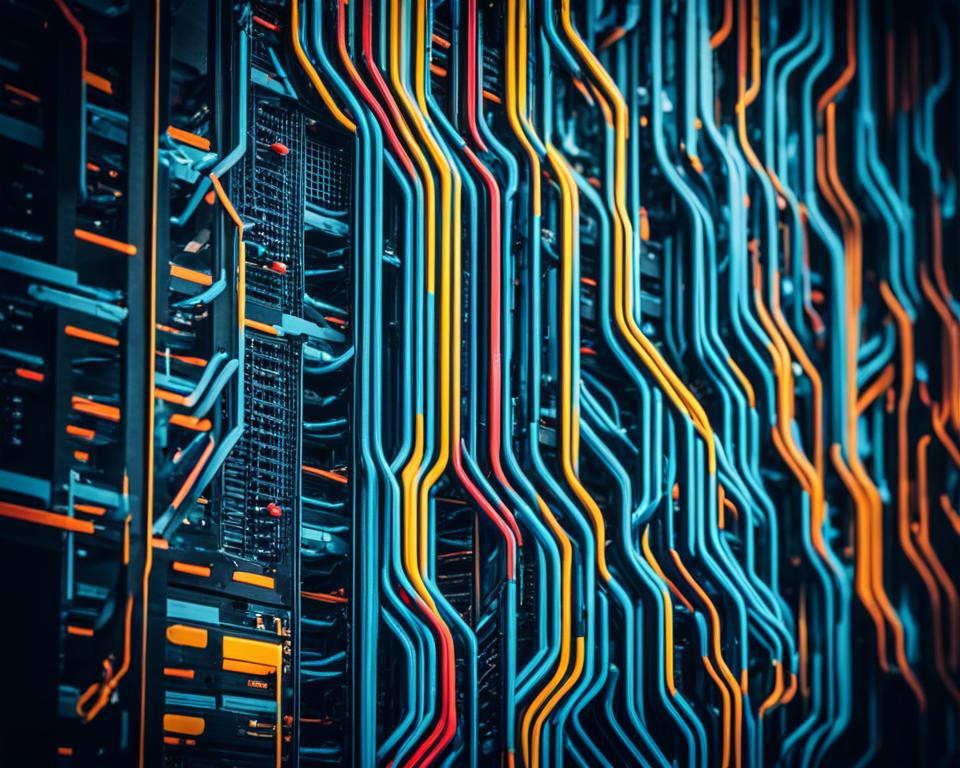
“A reliable and secure internet connection is the backbone of any server infrastructure. By investing in dedicated lines, appropriate bandwidth, and dependable internet service providers, businesses can ensure seamless connectivity and optimal performance for their servers.”
Security Cost
Ensuring the security of a server is of utmost importance in today’s digital landscape. Protecting against cyber threats and vulnerabilities requires investing in various security measures. Let’s explore the key components and associated costs.
1. Antivirus Software
Antivirus software is essential for detecting and eliminating malware, viruses, and other malicious programs that can compromise server integrity. The cost of antivirus software typically varies based on factors such as the number of licenses required and the level of protection offered. It’s crucial to choose a reputable and reliable antivirus solution to safeguard your server effectively.
2. Intrusion Detection System (IDS)
An Intrusion Detection System (IDS) is designed to identify and respond to unauthorized access attempts and suspicious activities on a server. It functions as a proactive security measure, continuously monitoring network traffic and logs in real-time. IDS solutions can be either network-based or host-based, each with its own cost considerations. Investing in an IDS helps mitigate potential security breaches and minimize the impact of unauthorized access.
3. Firewalls
A firewall serves as a barrier between the server and external networks, controlling incoming and outgoing network traffic based on predefined security rules. Firewalls come in hardware and software forms, each with its own associated costs. Hardware firewalls offer robust protection for enterprise-level servers, while software firewalls are generally more cost-effective for small to medium-sized businesses. Implementing a firewall is crucial for network security and safeguarding sensitive data.
4. Continuous Traffic Monitoring
Continuous traffic monitoring systems provide real-time analysis of network traffic and flag any suspicious or anomalous activities. These systems help detect potential threats and security vulnerabilities on a server. The cost of continuous traffic monitoring solutions can vary based on factors such as the scale of the server network, the complexity of traffic patterns, and the level of monitoring required. Investing in a reliable monitoring system ensures prompt identification and response to potential security breaches.
To illustrate the costs associated with server security measures, here’s an example:
| Security Measure | Cost |
|---|---|
| Antivirus Software (Annual Subscription) | $100 – $500 per server |
| Intrusion Detection System (IDS) (Hardware) | $1,000 – $5,000 |
| Firewall (Software) | $100 – $500 |
| Continuous Traffic Monitoring System | $500 – $1,500 per month |
These costs are approximate and can vary depending on factors such as the size and complexity of the server infrastructure, the level of protection required, and the specific security solution chosen.
Investing in robust security measures is crucial for safeguarding your server and protecting against cyber threats. By allocating resources to antivirus software, intrusion detection systems, firewalls, and continuous traffic monitoring, businesses can enhance server integrity, availability, and prevent potential data breaches.
Redundancy and Backup Cost
Redundancy and backup measures are crucial for minimizing downtime and preserving data integrity. These measures include redundant network connections, backup solutions, and hardware and software components. While these tools contribute to the overall cost of a server, they are essential for data protection and minimizing disruptions.
Implementing redundancy and backup systems ensures that your server remains operational even in the event of hardware or software failures. Redundant network connections provide backup paths, allowing for uninterrupted connectivity and smooth data transmission. This redundancy helps prevent potential bottlenecks or network outages that could affect business operations.
In addition, backup solutions play a vital role in protecting your data and ensuring its availability. Regular backups of critical data safeguard against accidental deletions, hardware failures, or cyberattacks. By having multiple copies of your data stored both on-site and off-site, you can quickly restore your server to a previous state in case of data loss.
While redundancy and backup measures add to the initial server cost, they provide invaluable data protection and help minimize the financial impact of potential disruptions. Investing in these measures can ultimately save your business from costly downtime, data loss, and reputational damage.
Redundancy and Backup Cost Considerations
When budgeting for redundancy and backup costs, it’s important to consider the following:
- The amount of data that needs to be backed up regularly
- The frequency of backups required
- The type of backup solution needed (e.g., local storage, cloud-based backup)
- The level of redundancy needed for network connections
- The scalability of the backup solution to accommodate future data growth
By evaluating these considerations, you can make informed decisions about the most appropriate and cost-effective redundancy and backup solutions for your business’s needs.
| Redundancy and Backup Cost Factors | Description |
|---|---|
| Redundant Network Connections | Cost associated with additional network infrastructure and equipment to establish redundant network paths. |
| Backup Solutions | Cost of backup software, storage devices, and cloud-based backup services. |
| Hardware and Software Components | Cost of redundant hardware (e.g., servers, storage devices) and software licenses for backup and failover systems. |
It’s important to note that the cost of implementing redundancy and backup measures can vary based on the size of your infrastructure, the complexity of your IT environment, and the specific requirements of your business.
“Data is the lifeblood of modern businesses. Investing in redundancy and backup measures is a proactive approach to data protection and business continuity.”
Conclusion
Understanding the costs associated with dedicated servers is essential for businesses to make informed decisions and effectively budget their resources. When considering dedicated server pricing, it is crucial to take into account various factors such as hardware costs, software costs, setup costs, maintenance costs, energy costs, connectivity costs, security costs, redundancy and backup costs, and depreciation costs.
By carefully assessing these aspects, businesses can optimize their server performance, scalability, and return on investment. The hardware cost of a dedicated server includes components such as memory, storage, processors, and networking equipment. The expense of these components varies based on their performance, quality, and scalability.
Additionally, software costs encompass the operating system, licenses, and additional applications required for functionality. Setup costs involve the installation, configuration, and deployment of the server infrastructure. Regular maintenance, energy consumption, connectivity, security, and redundancy measures also contribute to the overall pricing. By understanding these costs and considering their impact, businesses can make informed decisions to meet their specific server requirements.
FAQ
How much does a dedicated server cost?
The cost of a dedicated server varies depending on various factors, such as hardware specifications, software requirements, setup processes, maintenance needs, energy consumption, connectivity options, security measures, redundancy and backup solutions, and depreciation. By considering these factors and budgeting accordingly, businesses can estimate the overall pricing of a dedicated server.
What are the factors that influence server pricing?
Server pricing is influenced by several factors, including hardware costs, software costs, setup costs, maintenance costs, energy costs, connectivity costs, security costs, redundancy and backup costs, and depreciation costs. Each of these factors contributes to the overall pricing of a server and should be taken into account when considering the cost of a dedicated server.
What is included in the hardware cost of a dedicated server?
The hardware cost of a dedicated server includes networking equipment, memory, storage, and processors. The cost of these components can vary based on performance, quality, and scalability. Higher-end hardware options with advanced specifications may come at a higher cost. Businesses with heavy workloads and the need for faster performance should consider investing in more advanced hardware options.
What does the software cost of a dedicated server include?
The software cost of a dedicated server includes the operating system, software licenses, and additional applications and tools. Different operating systems have varying licensing fees, and additional software components may require subscriptions or licenses. Regular maintenance and updates of software components should also be considered when analyzing server pricing.
What is included in the setup cost of a dedicated server?
Setup costs refer to the installation, configuration, and deployment processes of a server. This includes physical installation of hardware components, wiring, rack mounting, and software configuration. The setup process is crucial for establishing a reliable and robust server infrastructure and should be considered when assessing server pricing.
What does the maintenance cost of a dedicated server include?
Regular maintenance is essential for the optimal performance and longevity of hardware and software components in a dedicated server. Maintenance costs include security and encryption updates, hardware repairs or replacements, and general preservation techniques. Neglecting regular maintenance can lead to security risks, disruptions in business processes, and decreased productivity.
What factors influence the energy cost of a dedicated server?
The energy cost of a dedicated server depends on factors such as cooling requirements, hardware efficiency, server architecture, and infrastructure size. Selecting energy-efficient servers and implementing effective cooling solutions can help reduce energy costs associated with server operations.
What is included in the connectivity cost of a dedicated server?
Maintaining a reliable and secure internet connection is crucial for server operations. Connectivity costs include the establishment and maintenance of dedicated lines, bandwidth fees, and internet connection quality. A reliable and secure internet connection contributes to optimal server performance.
What does the security cost of a dedicated server include?
Security costs for a dedicated server include expenses associated with antivirus software, intrusion detection systems, firewalls, and continuous traffic monitoring. Regular security audits, protective software, and monitoring contribute to maintaining server integrity, availability, and preventing data breaches.
What is included in the redundancy and backup cost of a dedicated server?
Redundancy and backup measures are essential for minimizing downtime and preserving data integrity. These measures include redundant network connections, backup solutions, and hardware and software components. While these tools contribute to the overall cost of a server, they are essential for data protection and minimizing disruptions.
How can businesses assess and budget for the overall cost of a dedicated server?
To assess and budget for the overall cost of a dedicated server, businesses should carefully consider factors such as hardware costs, software costs, setup costs, maintenance costs, energy costs, connectivity costs, security costs, redundancy and backup costs, and depreciation costs. By analyzing these factors, businesses can optimize their server performance, scalability, and return on investment.
